You’ll find construction 3D printing applications in three main areas: complete structure construction where entire homes can be built in 24 hours with 80% cost savings, individual component manufacturing for walls and architectural elements that reduces material waste by 60%, and infrastructure development including bridges, pipelines, and road barriers. The technology also enables rapid prototyping and architectural modeling, allowing quick design iterations and precise scaled models. Continue exploring to discover the specific methods and economic benefits driving this construction revolution.
What Is Construction 3D Printing Technology
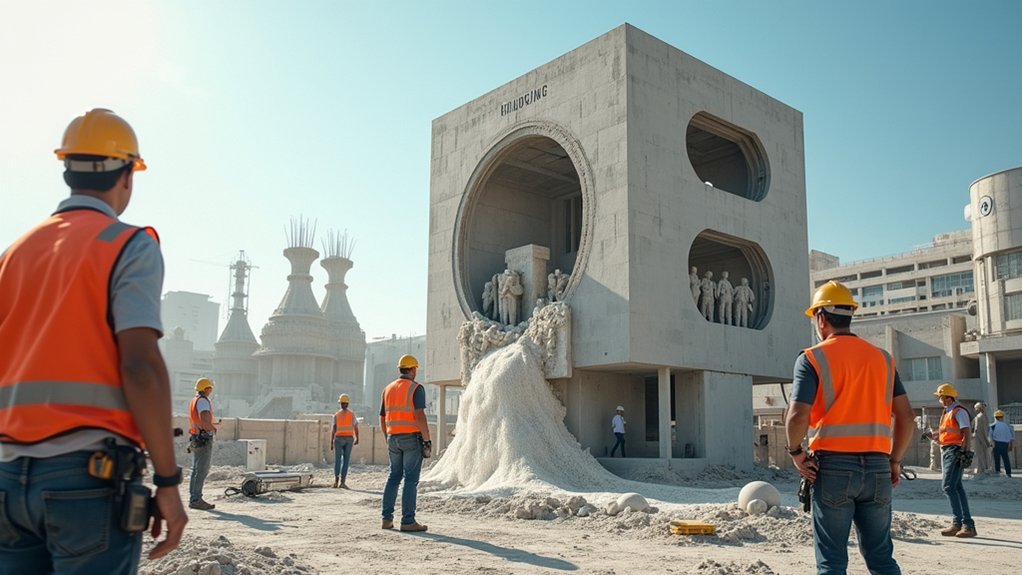
While traditional construction methods have remained largely unchanged for decades, construction 3D printing technology—also known as 3DCP (3D Construction Printing)—is revolutionizing how we build structures through automated, layer-by-layer additive manufacturing.
This innovative construction printing approach allows you to create building elements or entire structures both on-site and off-site with remarkable precision.
The technology seamlessly integrates with CAD and Building Information Modeling (BIM) systems, enhancing your printing efficiency by utilizing design data for accurate material overlay.
Materials used in this process include concrete, geo polymers, and various fibers, enabling you to construct durable and architecturally complex structures.
Through additive manufacturing, you’ll experience dramatically reduced construction times—some homes print in just 24 hours while cutting material waste by 60%.
Rapid Prototyping for Building Projects
Before committing to full-scale construction, you can leverage rapid prototyping through 3D printing to create precise scaled models that transform how you visualize and validate building designs. This printing technology revolutionizes the construction industry by drastically reducing prototype development time and costs while enabling multiple design iterations.
| Traditional Prototyping | 3D Printing Prototyping |
|---|---|
| Days to weeks timeline | Hours to complete models |
| High material costs | Reduced material waste |
| Limited design iterations | Multiple quick iterations |
You’ll integrate CAD drawings directly with construction planning software, enhancing cost and time estimate accuracy. These prototypes accurately assess structural integrity and design feasibility, leading to better-informed decisions during planning phases. By streamlining your construction process through rapid prototyping, you’ll accelerate entire project timelines considerably.
Architectural Scale Modeling and Visualization
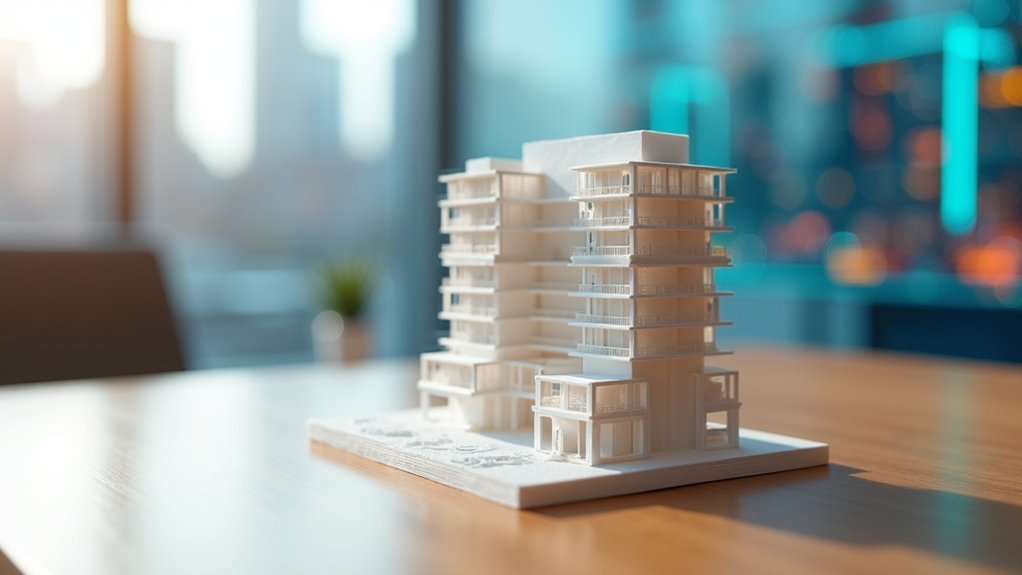
Architectural scale models created through 3D printing transform how you present and refine building designs, offering stakeholders a tangible representation that surpasses traditional 2D drawings and digital renderings.
You’ll produce detailed, accurate models that effectively communicate complex design concepts to investors and clients before breaking ground on construction sites.
With architectural scale modeling, you can rapidly iterate design changes without significant delays or costs. Your CAD designs integrate seamlessly with 3D printing technology, achieving precise dimensions that help assess structural integrity and feasibility.
This approach eliminates labor-intensive manual modeling methods, streamlining your entire design process. You’ll enhance visualization capabilities while reducing time-to-market for architectural presentations, enabling better decision-making throughout project development phases.
Full Structure Construction and Housing
You’re witnessing 3D printing technology evolve from creating small architectural models to constructing entire buildings at full scale.
Today’s printers can complete residential homes in just 24 hours while achieving up to 80% cost savings on labor and materials.
You’ll find applications expanding from single-family houses to commercial buildings and even multi-story developments that showcase the technology’s growing capabilities.
Residential Home Printing
Within 24 hours, you can watch an entire house materialize from the ground up through 3D printing technology, revolutionizing how we think about residential construction.
This printing in construction approach transforms how you’ll build your dream home, creating an entire building faster than traditional methods ever could.
The benefits of 3D printing in residential construction include:
- Dramatic cost savings – You’ll reduce construction expenses by up to 80% through minimized labor costs and 60% less material waste.
- Complete design freedom – You can customize every architectural detail to match your personal vision and lifestyle needs.
- Superior structural quality – You’ll get enhanced durability through optimized cement-based materials specifically engineered for 3D construction.
The market’s projected growth from $190 million to $680 million by 2030 reflects this technology’s transformative potential for homeowners.
Commercial Building Construction
Beyond residential applications, 3D printing technology scales seamlessly to tackle massive commercial building projects, where entire office complexes and retail spaces can be completed in just days rather than months.
You’ll find that commercial building construction using 3D printing dramatically reduces both material and labor costs—cutting materials available expenses by 60% and labor by 80%. This efficiency addresses urban housing shortages while supporting sustainable development through local materials available and minimal waste production.
The market’s explosive growth from $190 million in 2021 to a projected $680 million by 2030 demonstrates increasing confidence in 3D printing for commercial projects.
You’re witnessing a construction revolution that combines speed, cost-effectiveness, and environmental responsibility in large-scale building development.
Multi-Story Structure Development
As 3D printing technology advances to accommodate vertical construction, you can now witness entire multi-story buildings rising from foundation to roof through automated printing processes.
You’ll discover that robotic arm extruding and gantry systems enable the creation of complex geometries across multiple floors, with some multi-story structures completing construction in under 24 hours.
The construction market benefits from Building Information Modeling integration, which optimizes material usage and cost estimates for these ambitious projects.
You’re looking at a future where 3D printing can deliver:
- Five to six-story buildings completed within a year – transforming urban housing availability
- 80% reduction in labor and material costs – making homeownership dreams achievable for millions
- Precise automated construction eliminating human error – ensuring structural integrity and safety standards
Individual Building Component Manufacturing
Three distinct advantages make 3D printing particularly valuable for manufacturing individual building component manufacturing: speed, precision, and material efficiency.
You can rapidly produce walls, staircases, and structural elements directly on your construction site, greatly accelerating project timelines. This technology enables you to create unique architectural features and complex geometries tailored to your specific requirements.
You’ll benefit from utilizing various materials including concrete, polymers, and composites for different applications.
The precision achievable through 3D printing reduces waste by using only necessary materials, potentially lowering your costs by up to 60%. You can streamline your supply chain through on-demand production, minimizing storage and transportation expenses while maintaining quality control throughout the manufacturing process.
Infrastructure Elements and Civil Works
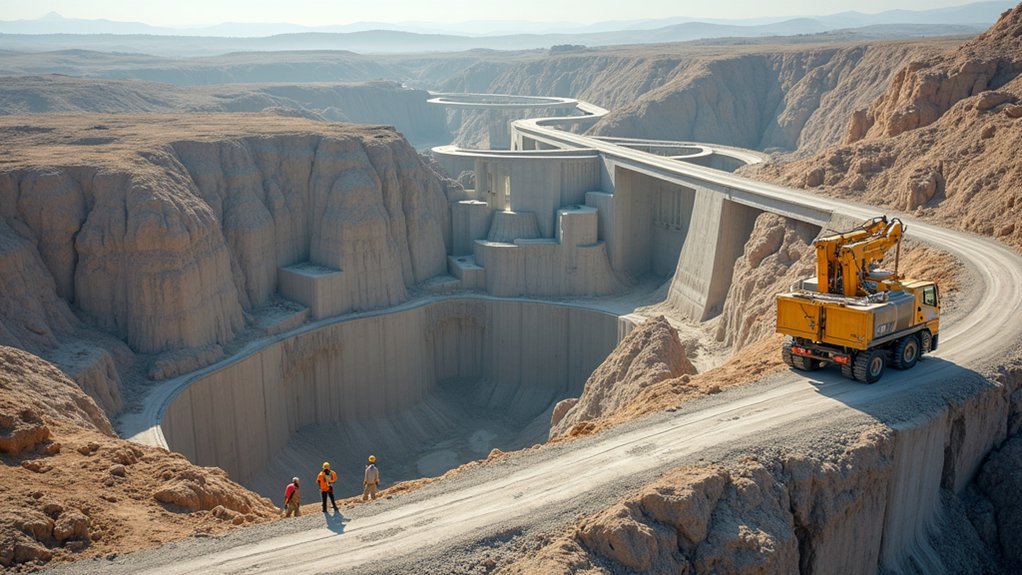
You’ll find that 3D printing’s transforming infrastructure development beyond individual components to complete civil engineering projects.
You can now create entire bridges, walkways, and utility systems using additive manufacturing, cutting construction time from months to days while reducing material waste by up to 60%.
You’re also seeing road construction elements being printed on-site, enabling complex geometries and custom designs that weren’t feasible with traditional methods.
Bridges and Walkways
When architects and engineers face the challenge of creating pedestrian bridges and walkways, 3D printing technology offers unprecedented opportunities to revolutionize infrastructure development.
You’ll find that construction projects using 3D printing achieve remarkable efficiency gains, with some walkways completed in days rather than traditional timelines spanning weeks or months. The technology enables you to create complex geometries that weren’t previously feasible with conventional methods.
Consider these transformative benefits:
- 60% reduction in material waste – You’re contributing to sustainable engineering while dramatically cutting project costs.
- On-site customization capabilities – You can adapt designs in real-time, eliminating transportation delays and expenses.
- Seamless urban integration – Your bridges become architectural statements that enhance community connectivity.
Projects like Madrid’s innovative 3D-printed bridge demonstrate how printing technology transforms modern construction practices.
Utility Infrastructure Systems
Beyond visible structures like bridges, 3D printing technology revolutionizes the hidden backbone of modern cities through utility infrastructure systems.
You’ll find this technology constructing water pipelines, sewage systems, and electrical conduits with unprecedented speed and customization. The process allows you to create complex geometries that traditional methods can’t achieve, resulting in more efficient drainage systems and intricate civil works.
Recent advancements in building materials like geo polymers and composites enhance your infrastructure’s durability against environmental stresses.
You’ll complete projects in days rather than months while reducing material waste by up to 60%. This sustainable approach minimizes environmental impact while delivering resilient infrastructure that meets specific project requirements with precision and efficiency.
Road Construction Elements
While traditional road construction relies on labor-intensive processes and standardized components, 3D printing technology transforms how you build essential infrastructure elements like barriers, sound walls, and drainage systems.
You’ll reduce material waste by up to 60% while creating complex geometries that enhance structural integrity and performance in civil works.
With robotic arm extruding technology, you can produce large-scale road elements using advanced materials like geo polymers for improved durability.
3D printed molds enable concrete casting that shortens project timelines considerably, with components ready within hours.
Benefits that’ll revolutionize your projects:
- Lightning-fast delivery – Components ready for installation in hours instead of days
- Massive cost savings – 60% reduction in material waste cuts budgets considerably
- Unmatched precision – Custom designs impossible with traditional methods
Robotic Arm Extrusion Systems
As construction 3D printing evolves, robotic arm extrusion systems emerge as one of the most versatile technologies in the field. You’ll find these systems offer unprecedented flexibility compared to traditional gantry setups, enabling complex geometries and diverse applications.
| Feature | Traditional Methods | Robotic Arm Systems |
|---|---|---|
| Flexibility | Limited movement | 360-degree rotation |
| Precision | Manual variance | Automated accuracy |
| Speed | Labor-intensive | Rapid completion |
| Waste | High material loss | Optimized usage |
| Cost | High labor expenses | Reduced workforce |
Construction companies increasingly adopt this printing process for cement applications, adding intricate wall elements and large components. Your robotic arm delivers enhanced precision in material deposition, greatly reducing labor costs and construction time while minimizing waste through improved resource efficiency.
Layer-by-Layer Material Deposition Methods
When construction professionals implement 3D printing technologies, they rely primarily on layer-by-layer material deposition methods that transform digital designs into physical structures through precise, incremental building processes.
You’ll find extrusion as the dominant technique, where nozzles deposit materials like concrete or thermoplastics in exact patterns. This approach enables you to create complex geometries with exceptional accuracy.
Alternatively, powder bonding methods use binder jetting to selectively fuse powdered materials, while spray techniques employ autonomous robots applying pressurized materials for larger spaces.
Revolutionary benefits of printing in the construction industry:
- 60% material waste reduction – dramatically cutting environmental impact
- Unlimited design freedom – creating impossible architectural components previously unachievable
- Faster project completion – accelerating timelines while maintaining structural integrity
These layer-by-layer processes revolutionize how you approach modern construction projects.
Concrete and Alternative Material Printing
When you’re working with 3D construction printing, you’ll primarily use concrete extrusion methods that push specialized concrete mixes through nozzles to build structures layer by layer.
You can also explore alternative materials like geo polymers, fiber-reinforced composites, and sand-based mixtures that offer enhanced sustainability and versatility for your projects.
The quality of your prints depends on factors such as material consistency, extrusion speed, and environmental conditions during the printing process.
Concrete Extrusion Methods
Concrete extrusion methods represent the most widely adopted approach in construction 3D printing, allowing you to build complex structures through the precise, layer-by-layer deposition of material directly from a specialized nozzle.
You’ll find this technology revolutionizing construction speed and efficiency.
These advanced systems enable remarkable achievements:
- Lightning-fast construction – You can print entire houses in under 24 hours, transforming traditional building timelines.
- Revolutionary sustainability – You’ll achieve up to 60% material waste reduction, protecting our environment for future generations.
- Unlimited creative freedom – Robotic arms with specialized nozzles let you create intricate designs impossible with conventional methods.
You’re witnessing enhanced capabilities through alternative materials like geo polymers and fiber composites, which strengthen structural properties while maintaining sustainability benefits that traditional construction simply can’t match.
Alternative Material Options
While concrete remains the foundation of construction 3D printing, you’ll discover an expanding universe of alternative materials that’s reshaping what’s possible in additive manufacturing. These sustainable options include geopolymer, fiber-reinforced composites, and bio-based materials that reduce material waste by up to 60%.
| Material Type | Key Benefits |
|---|---|
| Geopolymer | Enhanced durability, lower carbon footprint |
| Fiber-reinforced composites | Superior strength-to-weight ratio |
| Bio-based materials | Renewable sourcing, biodegradable properties |
| Lightweight mixtures | Reduced transportation costs |
| Custom blends | Tailored to specific environmental conditions |
You can mix and customize these alternative materials to create innovative designs suited for specific structural requirements. These emerging techniques enable lightweight construction, resulting in easier on-site handling while maintaining structural integrity and promoting environmental sustainability.
Print Quality Factors
As you shift from selecting materials to actual printing, achieving ideal print quality becomes your primary concern. The success of your structural components depends on mastering several essential factors that directly impact your final results.
Material properties play a fundamental role in determining print quality. You’ll need to carefully control viscosity and curing time of your concrete mixtures to achieve best surface finish and structural integrity.
Layer adhesion becomes vital – maintaining proper temperature control during extrusion prevents delamination and guarantees stronger connections between layers.
Your printer’s nozzle precision and calibration directly affect dimensional accuracy.
Consider these quality enhancement strategies:
- Monitor real-time performance – Advanced imaging systems help you catch defects before they compromise your entire structure.
- Enhance material flow – Perfect viscosity control creates smoother, more durable surfaces.
- Calibrate meticulously – Precise nozzle positioning guarantees your vision becomes reality.
Integration With CAD and BIM Software
The backbone of modern construction 3D printing lies in its seamless integration with CAD and BIM software systems.
You’ll find that CAD designs enable automated manufacturing of construction elements, boosting accuracy while cutting material waste by up to 60%.
When you utilize BIM, you’re ensuring your 3D printed components meet structural integrity and compliance standards throughout the entire process.
The integration of 3D printing with these software platforms gives you real-time design adjustment capabilities, facilitating rapid prototyping and dramatically reducing project turnaround times.
You’ll experience streamlined construction planning as this powerful synergy between CAD, BIM, and 3D printing technology greatly improves your cost and time estimates, making your workflow more efficient and precise.
Cost Reduction and Time Efficiency Benefits
Beyond streamlining design workflows, construction 3D printing delivers remarkable financial and temporal advantages that transform project economics.
You’ll achieve cost reduction of up to 80% through dramatically decreased labor costs and minimized material waste. Time efficiency reaches unprecedented levels when you can complete small homes in under 24 hours.
Your construction process becomes incredibly efficient with these game-changing benefits:
- Slash material waste by 60% – Watch your budget stretch further while protecting the environment
- Operate with just three workers – Solve labor shortages while maintaining quality and speed
- Complete rapid prototyping – Accelerate design assessments and project approvals instantly
This automation addresses industry labor shortages while delivering faster project completion times that’ll revolutionize your construction timeline expectations.
Frequently Asked Questions
What Are the Applications of 3D Printing in Construction Industry?
You’ll use 3D printing to construct entire buildings, create walls and floors, print molds for concrete casting, build bridges, integrate components into traditional methods, and develop rapid prototypes for architectural designs.
What Application Is Used for 3D Printing?
You’ll use specialized software like CAD programs to design models, then slicing software converts them into printable layers. Large-scale 3D printers with concrete or composite materials execute the construction process.
Where Is 3D Printing Used in Construction?
You’ll find 3D printing used for constructing entire buildings, creating structural components like walls and floors, building infrastructure such as bridges and railings, producing architectural models, and integrating with traditional construction methods.
What Are the Methods Used for 3D Printing for Construction?
You’ll find several methods for construction 3D printing: extrusion through robotic arms or gantry systems, powder bonding with binder jetting, spray applications using autonomous robots, and layering techniques that create complex architectural geometries.

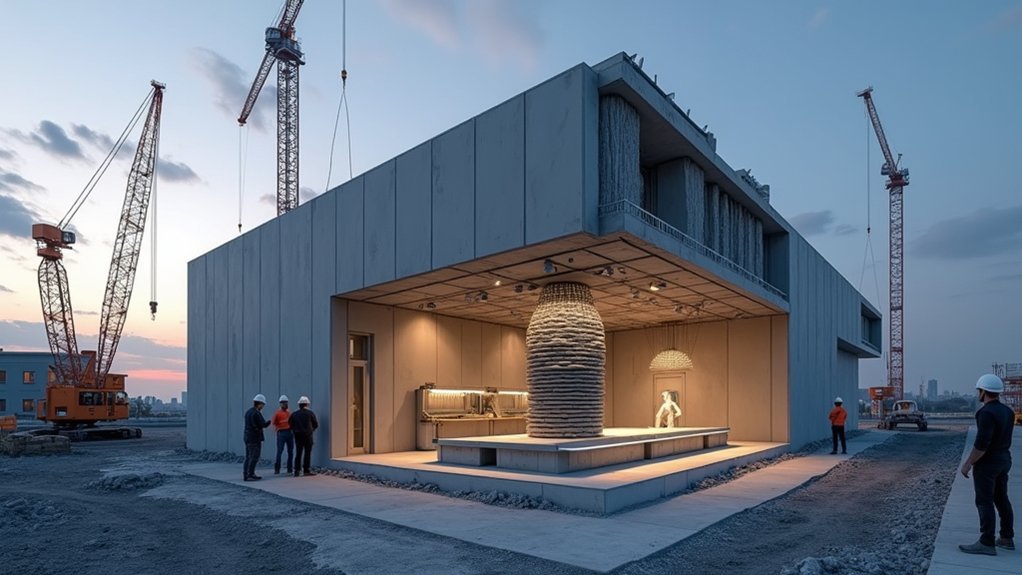

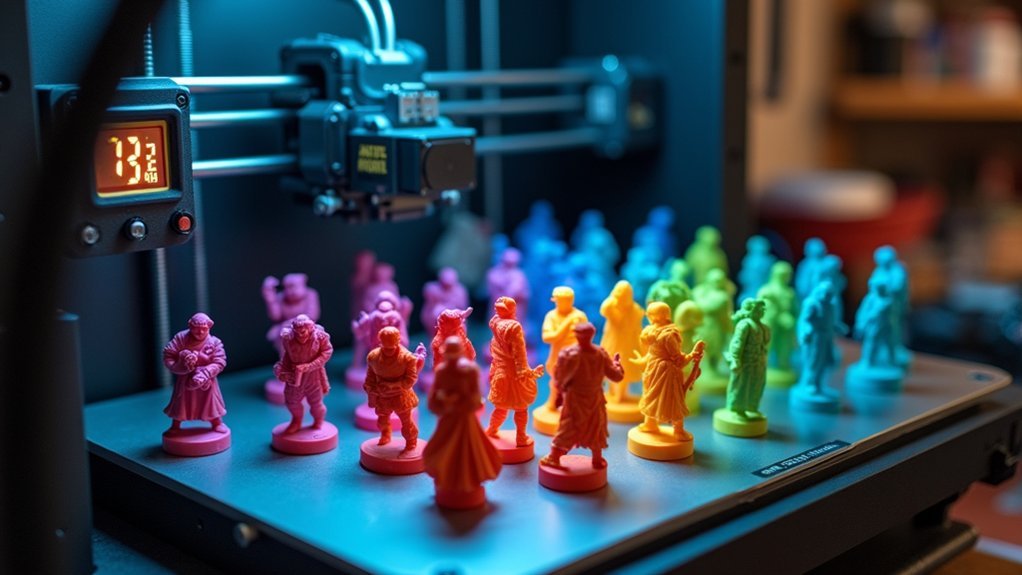
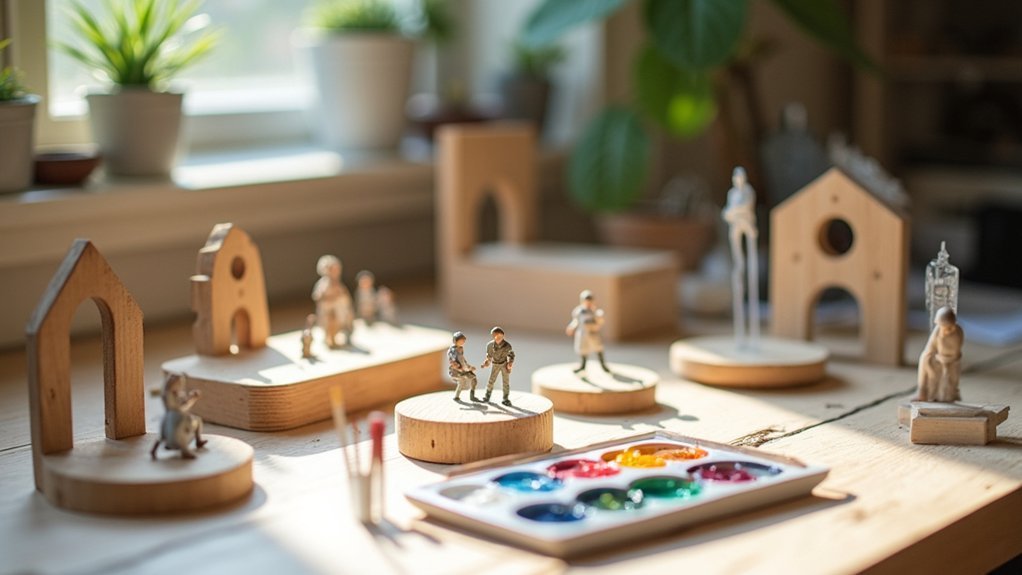
Leave a Reply